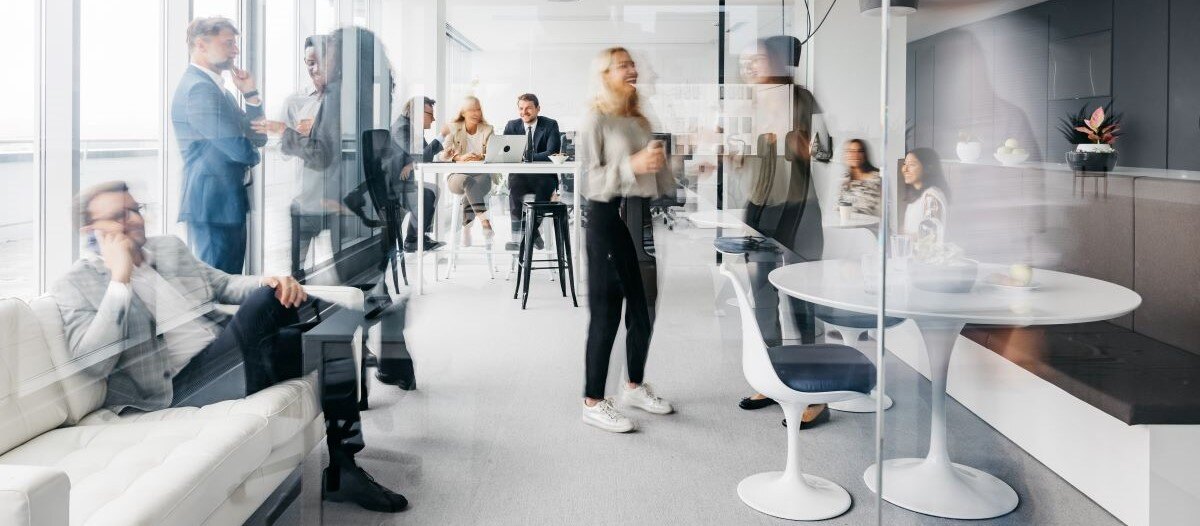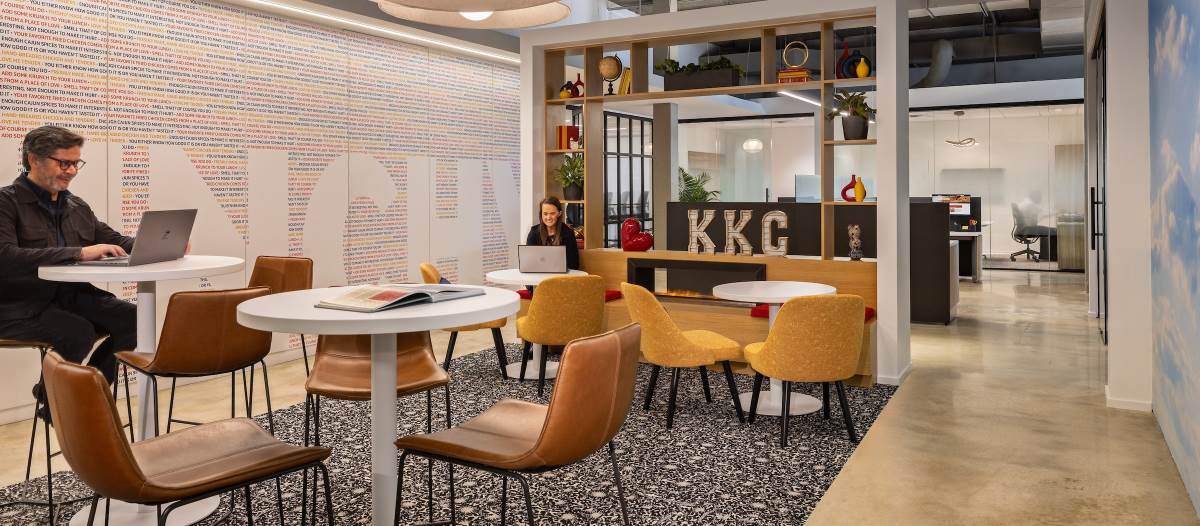A Mental Break
The rise of the wellness room

Growing awareness of mental health in the workplace has emerged as a powerful silver lining of the pandemic years. According to an American Psychological Association survey, seven in 10 workers (71 percent) say they believe their employer is more concerned about employee mental health now than they were in the past, while 81 percent say they will look for workplaces that support mental health in the future.
More than ever before, employers are investing in a range of programs to foster mental well-being, from meditation apps to access to counseling to yoga classes. But while these soft benefits are nice to have, facilities offer a unique chance for employers to match words with action, bringing what can seem like an abstract concept of well-being to life in physical space.
Amid the ongoing dance between employers and employees around return-to-work strategies, now is the time to double down on this opportunity. A recent Unispace report, Returning for Good, analyzed survey results from 3,000 office workers, noting a staggering 95 percent of employees would like to see improvements to their physical office space. If nothing else, it is safe to say this statistic indicates many people are unhappy with their current workplace.
So, what's the remedy?
For starters, remember that physical comfort, or lack thereof, has a profound impact on mental well-being. A comfortable setting with good air quality, lighting and thermal control supports focus while meeting physical, mental and emotional needs.
But to really drive mental well-being at work, facility leaders need to dedicate more square footage to the effort. Unispace research found that fewer than half of employees (38 percent) currently have access to designated well-being spaces.
By carving out specific areas where people can recharge during the workday, enterprises of all sizes can show employees their mental wellness and overall experience matter.
Whether workers use the space to zone out to calming music, take a nap, meditate, read, color or just be, employees who give themselves a break to recharge are not only more productive, but they also prove happier at work and more loyal to their organization.
The power of a wellness-centered workplace
People do their best work when they feel their best. So, in addition to being the right thing to do, supporting mental health through facility design is simply good business sense.
Today’s employees are under immense stress to be productive — and they are living up to the task. In this Information Age, knowledge workers are 10 times more productive than they were in the ’60s, thanks in large part to the unrelenting flow of real-time, 24/7 data. Is it therefore any wonder worker burnout is higher now than at the height of COVID-19?
Extreme mental exertion takes a toll on mental well-being. The sense that one must always be “on” to be deemed a worthy employee breeds anxiety, which over time, can lead to depression. At a minimum, the overexertion of adrenal glands shifts brain behavior into fight-or-flight mode on a regular basis, reducing the brain’s capacity to innovate and problem-solve by overloading it instead with endless deadlines, KPIs and productivity measures.
Stress, anxiety and other forms of mental exertion can also lead to higher costs for companies, including direct costs from insurance plan prices that increase when businesses have more claims, as well as indirect costs related to absenteeism.
Recent workplace design trends have focused on performance and productivity; but this is the moment to redirect focus toward giving people’s brains a much-deserved break.
Anatomy of a wellness room: 7 facility strategy considerations
Every organization can benefit from its own unique approach to wellness room design. In small businesses, it may be as simple as repurposing a private office or other underutilized room. For larger businesses, the concept could be replicated across an entire headquarters, with tweaks to personalize space for different teams on different floors.
Yet there are a few key guidelines to consider in developing an effective wellness room, such as:
- Do not mistake wellness for lactation. It may take a little extra creativity to come up with the space in a small business, but most organizations should be able to create distinct space for wellness, without impacting what is available for lactation needs. Similarly, an optimal wellness room need not double as a yoga or prayer room; ideally, those needs will be met by other spaces.
- Make sure people want to use the room — and feel empowered to do so. Align design with workplace culture by first asking what employees would value most in a wellness space. Use polls and surveys in the beginning; then down the line, check back in to see what improvements people might suggest.
Beyond that it is vital to ensure employees feel encouraged to use the space; there should be no sense of guilt or shame in taking advantage of a wellness room. - Convey that this is a mood-based space from the inside out. The rest of the workplace is designed for people to be productive and awesome. This is the one space where it is okay to not be those things. Use design cues to signal that this is a restful space meant for recharge; but also use clear signage to send the message home. For example: “This wellness room is a designated No-call Zone. Because you deserve it.”
- Give employees the sense of comfort and control they crave. Employers think that commutes are the biggest issue in return-to-work, according to Unispace surveys. But employees cite the inability to control an environment as a bigger deterrent than the commute.
When people got used to working from home, they also got used to controlling their environments. Comfortable couches, softer lighting and the ability to lie down for a power nap or daydream break became routine.
Bring that sense of comfort and control to the wellness room with a range of tactics, from dimmable lights, ambient sound selection and thermostat control, to cushy couches long enough to stretch out on and snooze. - Make this room feel like a spa with sensory design. It may be tempting to throw a prayer rug or yoga mat into an old supply closet and call it a wellness room, but that does not inspire serenity or reflect awareness. From calming color schemes to noise-minimizing acoustics to Feng Shui, the wellness room can and should be as calming as a spa environment.
For example, by using indirect lighting like upward-facing light fixtures or gentle lamps, facility leaders can support the comfort of people experiencing migraines or neurodiverse people who may be sensitive to bright light. - Tie in natural elements. The concept of biophilia — that humans have an innate tendency to connect with nature — has made a splash in workplace design over the last decade. Bring that sensibility into the wellness room with potted plants, green walls and/or peaceful, nature-inspired artwork.
- Consider whether there’s an opportunity to pursue WELL certification. Providing a designated restorative space can also help companies achieve WELL certification, which in turn fuels recruitment and retention. As the designation states, the space “may serve multiple functions but is not to be used for work.”
This calming and comfortable environment should include signage expressing its purpose and incorporate at least five of the following:- Adjustable lighting
- Sound interventions
- Thermal control
- Flexible seating arrangements
- Natural elements
- Calming colors, textures and forms
- Visual privacy
The future of work is, above all, human
Mental exhaustion is not a sign of weakness; it is a sign of being human. Employees across all sectors and around the world have experienced trauma over the last few years, from the ongoing toll of the COVID-19 pandemic to social unrest, climate change and economic uncertainty.
By prioritizing employee mental health as a strategic principle, employers can empower their teams to feel more connected to the organization, lessen absenteeism and strengthen workplace culture.
And they can bring that principle roaring to life by shaping designated wellness rooms. A spa-like, sensory-driven space can show that an organization’s commitment to mental wellness is more than just lip service, it is backed by an investment in square footage that is more than worth the cost.
Every organization does better when its employees feel better. In a post-pandemic world, a good wellness room (or better yet, a collection of them) is becoming a business imperative as more companies recognize what matters most to success: their people.

Regan Donoghue, senior principal at Unispace is a seasoned strategist with more than 15 years of experience helping clients challenged by complexities that arise in the world of workforce and workplace strategy. She takes on more turbulent paths, specializing in guiding clients through scenario planning, designing change plans and developing predictions on the future of the workplace. With a fresh, empathetic approach to current workforce challenges, Donoghue works closely with clients to enhance the quality of user experience, creating a better understanding of what they truly value and want from their company. As a WELL & LEED Accredited Professional, she guides the best solutions to support employees' mental, physical and emotional well-being at work.
Read more on Occupancy & Human Factors , Real Estate and Workplace
Explore All FMJ Topics









